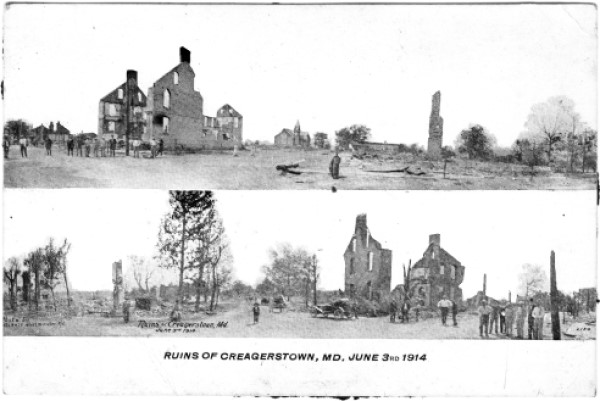by James Rada, Jr.
Early in the morning of June 2, 1914, a fire started in the engine room of the Monocacy Valley Creamery in Creagerstown. No reason was given as to just what happened, but the fire was soon out of control.
“The flames quickly communicated from one building to the other and made an almost clean sweep on both sides of the street,” the Catoctin Clarion reported.
The town hall burned. The B.F. Bell house, blacksmith shop, ice house, and buggy shed succumbed to the flames. Both hotels—the Valley Hotel, run by C. L. Valentine, and H. Jefferson Krise’s hotel—burned. Barn Freeze’s house and barbershop were lost. The Ogle store and the millinery store were lost.
“One house after the other fell prey to the flames and with great difficulty furniture and other personal effects were saved,” the Frederick News reported. In all, a dozen homes were lost and others found themselves without roofs.
Residents hurried to remove their homes of furnishings, clothing, and other goods, and take them out of reach of the fire.
People from other towns rushed to Creagerstown to help, but it was impossible to check the flames. The day was warm, and the heat from the fire was intense.
“As soon as word was received at Thurmont that help was needed, men began answering the call. Mr. Lester Birely with Mayor Root and several others with buckets and axes left in an automobile,” the Clarion reported. They also brought ladders so people could climb onto roofs to soak them and hinder the fire’s spread.
County Commissioner Stevens, who owned the town hall building in Creagerstown, was in Frederick when he heard about the fire. He rushed to Creagerstown in his car so quickly that the top blew off of it. He later offered a reward for its return.
Park W. T. Loy, chief of the Independent Hose Company in Frederick, had fire equipment loaded onto the Thurmont trolley. Then, he called the town hall in Thurmont and asked that the townspeople build a trestle to offload the heavy equipment when it reached the town and make arrangements for horses to pull the equipment to Creagerstown. He also called someone in Creagerstown and told them that the townspeople needed to dam up the small stream running near the town so that the fire equipment could use the water to fight the fire.
There were no major injuries fighting the fire, although there were some close calls. Gordon Troxell was burned around his eyes, and M. L. Creager was on a roof fighting a fire when it trapped him. He had to jump to another roof to escape.
“It looked as if the whole town would be wiped off the map,” the News reported.
Driven by wind, the fire eventually reached the Lutheran Church, but then winds died down before the fire caught the church on fire. The flames were brought under control around 1:30 p.m.
Meanwhile, the Thurmont trolley with the Independent Hose Company equipment aboard, jumped the rail at Isanogle’s switch. By the time the trolley was back on the tracks and the equipment reached Thurmont, the flames were already under control.
Coming into the town, the Clarion reported, “Furniture, bedclothes, wearing apparel and everything used about a home could be seen lying along the streets and in the field to the west of the fire, an armful from one house thrown on a pile from some other home.”
The loss was immense. With so many homes and businesses burned, the town of 200 residents was virtually gone. The only remaining homes were those where Calvin Ogle, Marion Warner, Allen Yingling, and Mrs. and Dr. Devilbiss lived on the west side of the street, and the homes of John M. Ahalt, Harry Lohr, William Speak, and Blanche and Core Stull on the east side of the street.
The loss was estimated to be around $70,000 (about $2 million in today’s dollars).

A postcard image that shows the aftermath of the Creagerstown Fire.

